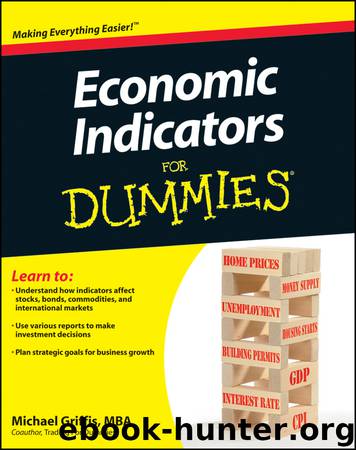Economic Indicators For Dummies by Michael Griffis

Author:Michael Griffis
Language: eng
Format: epub
Publisher: Wiley
Published: 2011-09-02T04:00:00+00:00
Figure 8-1: Industrial Production and Capacity Utilization summary.
As you can see in Figure 8-1, the report expresses industrial production in the following ways:
Total index: This category shows the previous six months of industrial production data as a percentage of the base year in 2007. The values for all but the current month are revised from previous estimates. You can see the previous estimates in the second line of the data summary.
For example, the reported industrial production for January 2011 was 95.1, meaning that total industrial production in that month was 95.1 percent of what it was in January 2007.
Major market groups: This category shows the output of finished products as well as the materials and equipment necessary to manufacture products.
Major industry groups: This category shows output by major industry classification, as defined by the widely used North American Industry Classification System (NAICS) industry codes. The primary NAICS classifications include durable and nondurable manufacturing, mining, and utilities. Manufacturing is by far the largest component of the three.
The Industrial Production and Capacity Utilization report expresses capacity utilization in the following ways (refer to Figure 8-1):
Total industry: This category shows the high and low capacity utilization values, average capacity, and month-to-month and year-over-year changes.
Manufacturing, mining, and utilities: This category shows the total industry utilization broken down into manufacturing, mining, and utilities. The layout is the same as for total industry.
Stage-of-process groups: This category shows the utilization of various steps in manufacturing processes. The crude processing stage includes raw materials like lumber or mined metals. The primary and semifinished processing stage includes output from the crude processing stage. And the finished processing stage includes output from the primary and semifinished processing stage. The purpose of this particular summary is to show any steps in the manufacturing chain that may slow or constrain a later stage of production.
A complete description of the major market groups and major industry groups, including details regarding series classification, relative weights, and data sources, is available on the Fed’s website at www.federalreserve.gov/releases/g17/about.htm. For more about the NAICS industry codes, go to www.census.gov/naics/.
Although the reported industrial production figures don’t consider price — only output — you can use them to calculate a monthly estimate for the GDP growth rate. Your estimate won’t be perfect, but it’ll be close. If you figure out the annualized three-month percentage change in industrial output and multiply it by the annualized three-month percentage change in consumer inflation, the result is a very good approximation of the annualized real (inflation-adjusted) GDP growth rate.
Repositioning your portfolio
Although traders may not jump when the Industrial Production and Capacity Utilization report is released, it provides a great deal of information for thoughtful investors and business leaders. In addition to the summary shown in Figure 8-1, the Industrial Production and Capacity Utilization report shows a dozen charts and more than a dozen data tables. Investors and business leaders can find useful information in both.
The charts show the relationship between total production and total capacity over time, as well as the relationship between outputs of various industries.
Download
This site does not store any files on its server. We only index and link to content provided by other sites. Please contact the content providers to delete copyright contents if any and email us, we'll remove relevant links or contents immediately.
International Integration of the Brazilian Economy by Elias C. Grivoyannis(75362)
The Radium Girls by Kate Moore(11624)
Turbulence by E. J. Noyes(7704)
Nudge - Improving Decisions about Health, Wealth, and Happiness by Thaler Sunstein(7247)
The Black Swan by Nassim Nicholas Taleb(6772)
Rich Dad Poor Dad by Robert T. Kiyosaki(6185)
Pioneering Portfolio Management by David F. Swensen(6083)
Man-made Catastrophes and Risk Information Concealment by Dmitry Chernov & Didier Sornette(5655)
Zero to One by Peter Thiel(5495)
Secrecy World by Jake Bernstein(4390)
Millionaire: The Philanderer, Gambler, and Duelist Who Invented Modern Finance by Janet Gleeson(4105)
The Age of Surveillance Capitalism by Shoshana Zuboff(3990)
Skin in the Game by Nassim Nicholas Taleb(3973)
The Money Culture by Michael Lewis(3850)
Bullshit Jobs by David Graeber(3837)
Skin in the Game: Hidden Asymmetries in Daily Life by Nassim Nicholas Taleb(3729)
The Dhandho Investor by Mohnish Pabrai(3562)
The Wisdom of Finance by Mihir Desai(3528)
Blockchain Basics by Daniel Drescher(3332)
